Statement on Monetary Policy – November 2017 3. Domestic Economic Conditions
Domestic economic conditions have improved since earlier in the year, supported by low interest rates, growth in public spending and continued strength in the global economy. The adjustment of the Australian economy to the cycle in mining investment is well advanced. Employment growth has been strong over the past year, particularly for full-time employment. The unemployment rate has declined a little further recently, although there is still spare capacity in the labour market and wage growth remains low.
Domestic GDP growth increased in the June quarter; growth in most components of expenditure picked up, although mining investment declined (Table 3.1; Graph 3.1).
| June quarter 2017 | March quarter 2017 | Year to June quarter 2017 | |
|---|---|---|---|
| GDP | 0.8 | 0.3 | 1.8 |
| Domestic final demand | 1.0 | 0.6 | 2.4 |
| – Consumption | 0.7 | 0.5 | 2.6 |
| – Dwelling investment | 0.2 | −3.7 | −2.5 |
| – Mining investment | −1.9 | 2.4 | −9.8 |
| – Non-mining investment | 2.3 | 2.1 | 6.1 |
| – Public demand | 2.2 | 0.5 | 3.9 |
| Change in inventories(a) | −0.6 | 0.4 | −0.3 |
| Exports | 2.7 | −2.2 | 4.3 |
| Imports | 1.2 | 2.2 | 6.5 |
| Mining activity(b) | 1.6 | 0.8 | 3.5 |
| Non-mining activity(b) | 0.7 | 0.3 | 1.6 |
| Nominal GDP | −0.1 | 2.3 | 6.3 |
| Real gross domestic income | −0.5 | 1.5 | 4.7 |
| Terms of trade | −6.0 | 5.7 | 14.9 |
|
(a) Contribution to GDP growth Sources: ABS; RBA |
|||
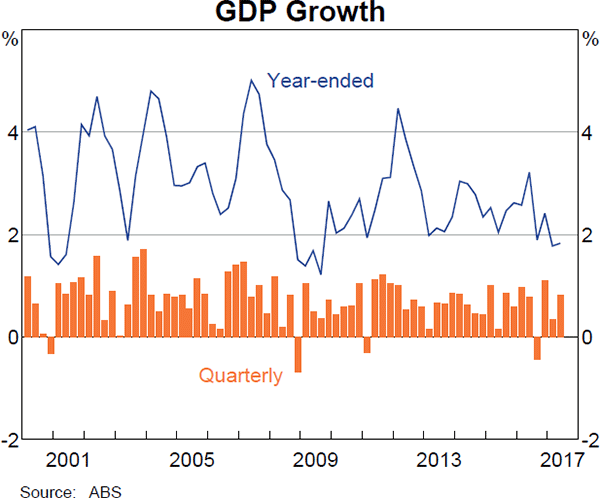
The economy looks to have expanded at a modestly slower rate in the September quarter. However, taking the year as a whole, this would imply an increase in year-ended growth to around estimates of potential growth. Looking forward, the economy is expected to strengthen. This is expected to reduce spare capacity in the labour market further and lead to a gradual increase in wage growth and inflation.
The divergence between economic conditions across the states has continued to narrow (Graph 3.2). The rate of decline in state final demand in Western Australia slowed over the year as the drag from mining investment diminished. Employment growth has been strong in Western Australia over the past year and the unemployment rate has fallen. In Queensland, growth in state final demand has increased, following a number of years of below-trend growth. In the rest of the country, final demand has continued to expand at an above-average rate.
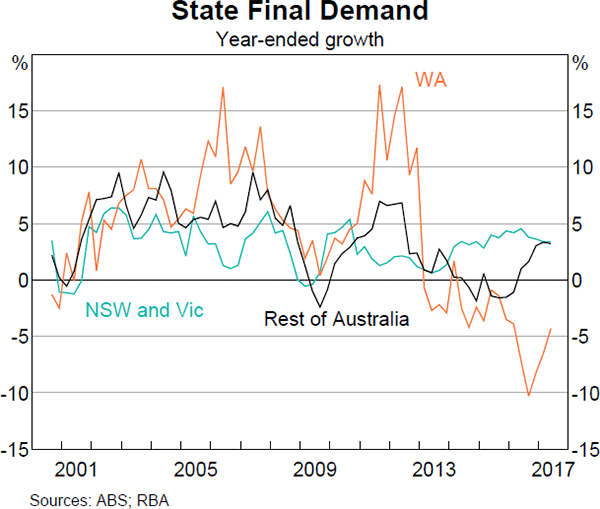
Mining Activity
The mining sector has contributed positively to domestic GDP growth over recent quarters; the drag on growth since 2012 from falling mining investment has continued to dissipate and resource exports have increased further (Graph 3.3).
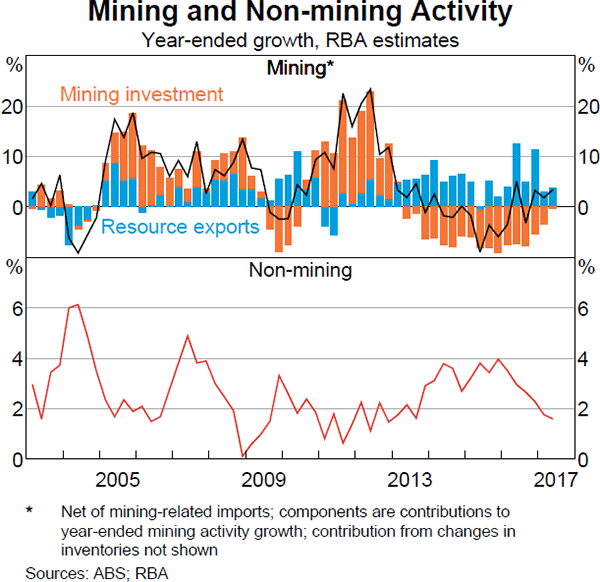
While mining investment fell in the June quarter and is expected to fall a bit more over coming quarters, the largest declines have already occurred; both the ABS capital expenditure (Capex) survey of investment intentions and Bank liaison point to smaller declines in mining investment over the period ahead. Much of the remaining decline is expected to be in liquefied natural gas (LNG) investment as the construction phase of large projects is completed. The level of mining investment is then expected to stabilise in the second half of next year; while very few new large projects are expected to commence, major mining firms are likely to invest to maintain their existing productive capacity.
Resource export volumes have grown strongly over recent years as more production capacity has come on line. The increase over the past year was driven largely by LNG production (Graph 3.4). LNG exports are expected to contribute just above ⅓ percentage point to annual GDP growth over the next couple of years as existing plants ramp up production and new plants come on line (this is a little lower than previously expected due to delays at some projects and lower production than had been expected at some others). Iron ore export volumes remain at high levels and are expected to rise only a little further in the period ahead as additional production capacity from Australia's low-cost producers comes on line (see ‘Box A: The Chinese Steel Market and Demand for Bulk Commodities’).
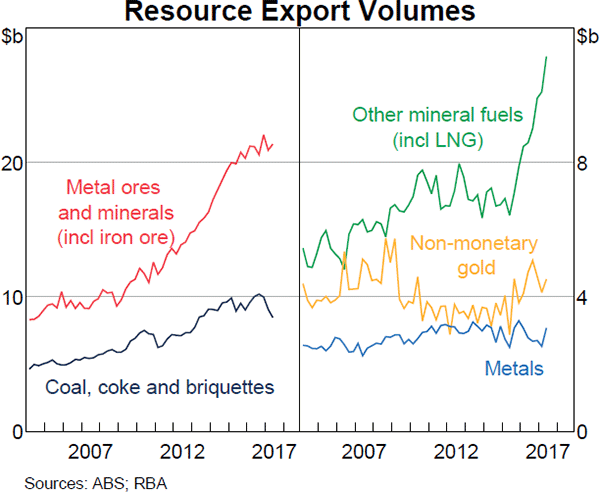
Coal export volumes declined sharply in the June quarter, as had been anticipated after Cyclone Debbie damaged key coal rail infrastructure in the Bowen Basin. Coal exports look to have rebounded in the September quarter. Coking coal shipments returned to pre-cyclone levels in May and liaison information and timely data suggest that exports have remained at a high level since then. China, Japan, India and South Korea remain the primary destinations for Australia's coking coal exports, reflecting the significant levels of steel production in these economies (Graph 3.5). Thermal coal exports to China have increased over the past year or so, offsetting declines in exports to South Korea and some other countries.
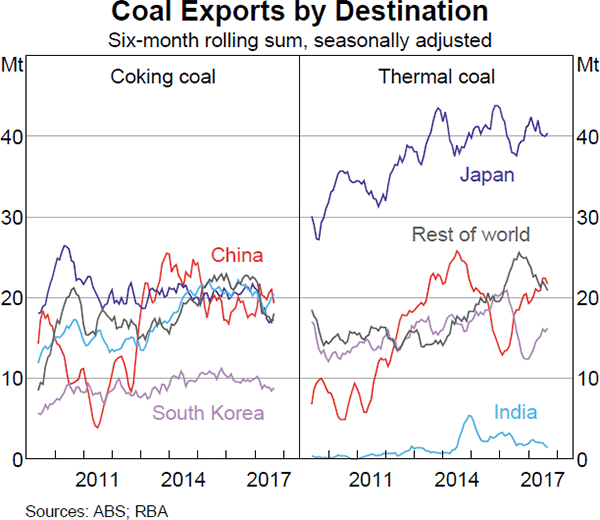
Although resource export volumes have grown strongly for some time now, the improvement in mining profits since early 2016 has been driven largely by the sizeable increase in bulk commodity prices over that period (which also drove the increase in the terms of trade from early last year; Graph 3.6). Information from company announcements has indicated that mining firms have generally used the additional income to pay down debt, pay dividends and increase share buybacks, rather than expand production capacity through new investment. This suggests that companies did not expect the higher prices to be sustained; prices have since declined (see ‘International Economic Developments’ chapter). Some mining firms have reportedly undertaken small-scale investments in machinery and equipment.
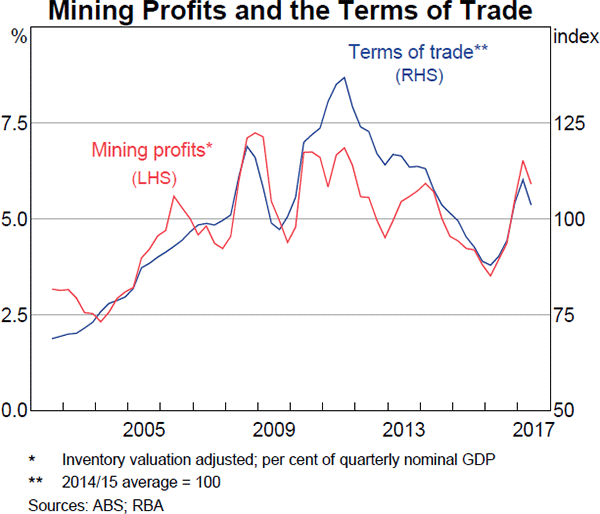
Household Sector
Growth in household consumption picked up in the June quarter to a moderate rate, and in year-ended terms was around the average since the global financial crisis (Graph 3.7). The pick-up in the quarter reflected stronger growth in goods consumption. Growth in consumption of services, which had been stronger over the past few years, was weak in the quarter. Consumption growth remained strongest in the eastern states but also picked up slightly in Western Australia in the quarter.

Some timely indicators of consumption point to subdued growth in the September quarter. There was broad-based weakness in retail sales in the quarter, particularly for household goods (Graph 3.8). However, employment growth has been strong recently and surveys of consumer sentiment have increased to be around their long-run average, which may support consumption in the near term.
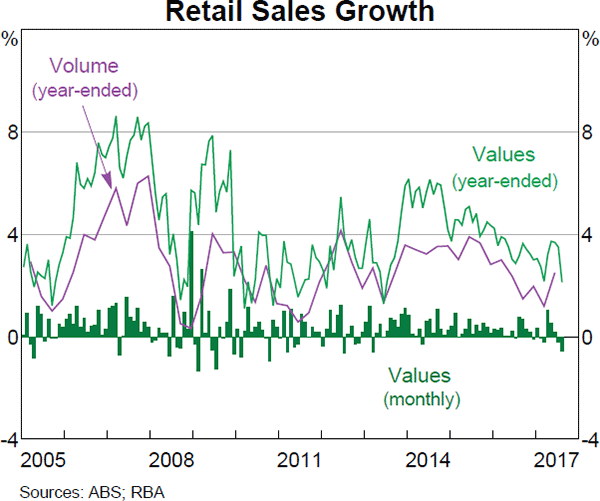
More generally, household consumption growth has held up reasonably well over recent years, given the below-average growth in household income over this period. Growth in labour income, which is the largest component of household income, has been subdued (see ‘Labour Costs’ below). Growth in non-labour income, which includes earnings from unincorporated enterprises and income earned from properties, has been a bit below average. The subdued growth in household income has been relatively broad based by state, although it has been most pronounced in Western Australia.
With consumption growth holding up over the past few years, despite lower income growth, the share of households' income that is saved has declined (Graph 3.7). The decline has been concentrated in the mining states, where income growth has been weaker over this period; these states had previously recorded larger increases in their saving ratios during the 2000s, when their income growth was relatively strong. Household saving ratios have been relatively stable in New South Wales and Victoria.
Conditions in established housing markets have eased in recent months. The Sydney market has slowed noticeably; auction clearance rates have fallen and housing price growth has been relatively subdued over the past few months, although this follows very strong increases in housing prices over the second half of 2016 and early 2017 (Graph 3.9 and Graph 3.10). Conditions remain strongest in Melbourne; vendor discounts and days on market continue to point to very strong conditions, although housing price inflation and the auction clearance rate have declined a little. The more pronounced slowing in the Sydney housing market relative to Melbourne may reflect the higher share of investors in the Sydney market; the flow of loan approvals to these buyers has slowed since the beginning of the year. Housing prices in Sydney are also higher, so affordability could be more of a constraint than in Melbourne. Higher migration flows to Victoria, both from overseas and interstate, are also supporting the demand for housing (Graph 3.21).
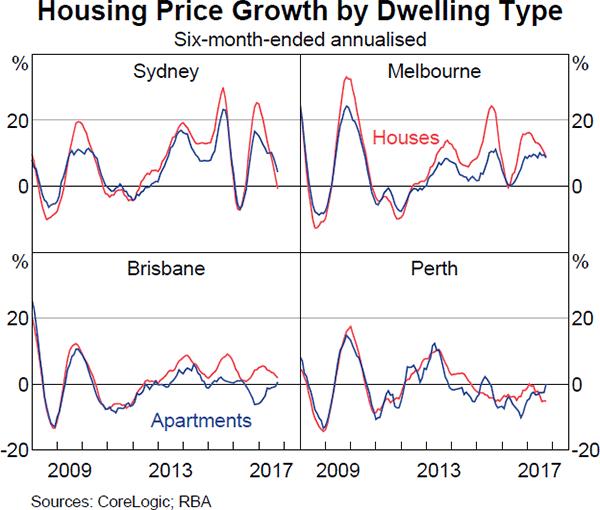
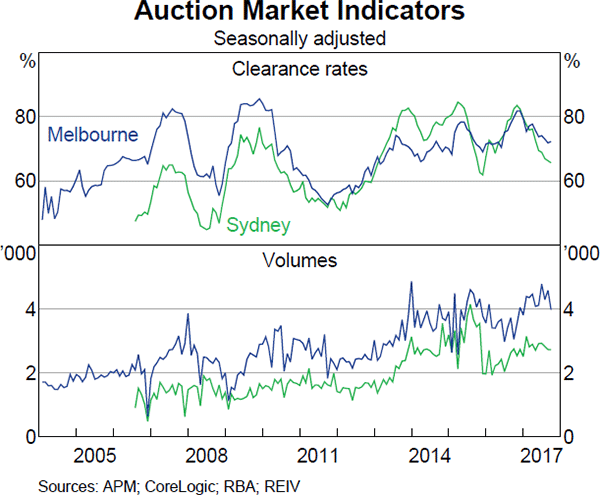
Housing prices have declined a little further in Perth, where the rental vacancy rate has increased to its highest level since 1990, driven by the slowing in population growth (Graph 3.11). In Brisbane, apartment prices have been little changed in recent months following earlier declines, while detached house prices have increased.

The value of housing loan approvals has been little changed in aggregate in the past few months (see ‘Domestic Financial Markets’ chapter).
High housing prices in the largest cities, related to relatively strong population growth, have encouraged new dwelling construction and alterations & additions in recent years (Graph 3.12). Residential dwelling investment remains high, although it is a little lower than in late 2016 and may have peaked in the current cycle. High-density construction, particularly high-rise apartments, continues to account for a relatively large share of construction activity.

In terms of the outlook for dwelling investment, residential building approvals have been lower over the past year than they were over the preceding two years, particularly for higher-density housing (Graph 3.13). The decline in building approvals is likely to reflect several factors. Liaison with developers indicates that demand for off-the-plan apartments in the major east-coast cities has moderated, reflecting weaker demand from foreign buyers and domestic investors. Developers' access to bank finance – which is secured before obtaining a building approval – has tightened over the past year or so, particularly in areas where there have been very large increases in the supply of apartments, such as inner-city Brisbane. These factors may continue to weigh on building approvals in the coming year. In contrast, demand for new detached housing and greenfield land, which is generally used for detached housing and medium-density developments, has been robust in the eastern capital cities, particularly Melbourne. In Perth, housing market conditions remain weak, though building approvals appear to have stabilised in recent months.
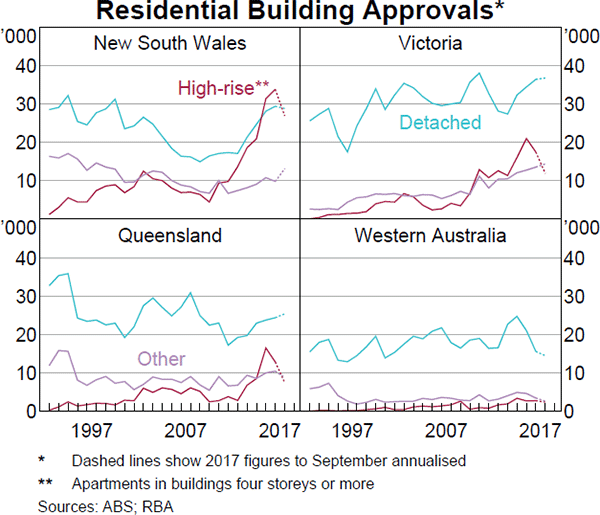
Even though the level of residential building approvals has declined, dwelling investment is likely to remain at a high level for the next year or so because of the large pipeline of work already approved or underway, especially in New South Wales (Graph 3.14). The earlier build-up in the pipeline was driven by apartment projects, which typically take around three times longer to complete than detached houses.
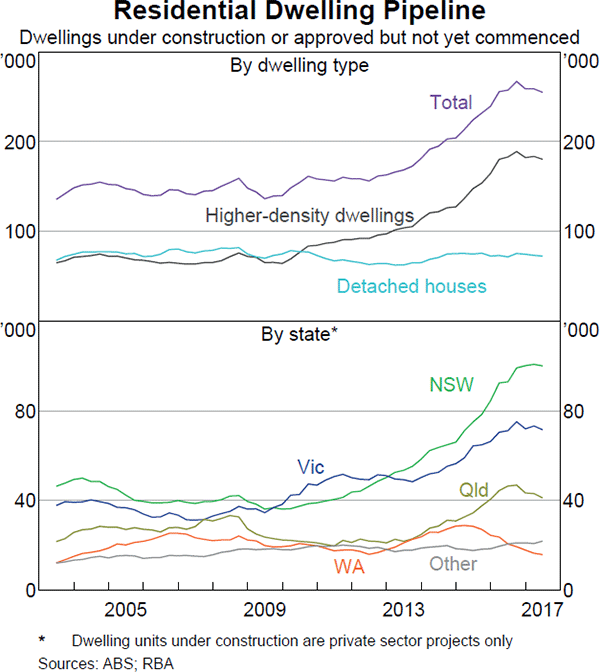
Government Sector
Public demand growth remained strong in the June quarter, for both consumption and investment. The recent strength in public investment has been driven mainly by an increase in infrastructure construction, particularly in telecommunications and transport (Graph 3.15). Much of this work has been done by the private sector for the public sector, which liaison contacts and business surveys suggest has supported business conditions over the past year or so. More recently, liaison contacts have reported that these contracts to complete public infrastructure works have begun to support their own private investment in machinery and equipment. State and federal budgets suggest that public investment will remain strong over the next year or more as work continues on infrastructure projects. This will also contribute to import growth over the forecast period, as the import intensity of public investment is fairly high compared with other expenditure components.
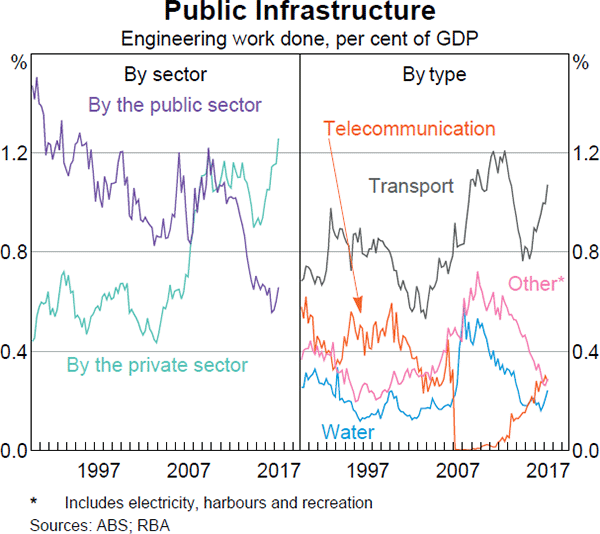
Non-mining Business Investment and Trade
Non-mining business investment has been rising gradually for a number of years, and has increased by almost 10 per cent since the start of 2016. Recent revisions to the national accounts data indicate that non-mining investment growth has been stronger than previously reported. The outlook for non-mining investment is being supported by low interest rates, the expected pick-up in GDP growth and the diminishing impact of falling mining investment on other sectors of the economy, particularly in Western Australia and Queensland.
On balance, forward-looking indicators of non-mining business investment have improved somewhat and are now pointing to further growth in investment in the period ahead. Investment intentions for 2017/18 reported by firms in the ABS Capex survey were revised higher in the most recent survey, but suggest that growth will be moderate at best over the next year (Graph 3.16).[1] Private non-residential building approvals remain around their highest level for some time (Graph 3.17). The stock of private non-residential building work yet to be done has risen in recent quarters, but it remains low relative to recent history. As noted earlier, the large pipeline of public infrastructure spending should continue to have positive flow-on effects to private business investment. Survey measures of capacity utilisation have improved over the past year, particularly for goods-producing firms. The NAB survey measure of investment intentions has also increased over the past year.
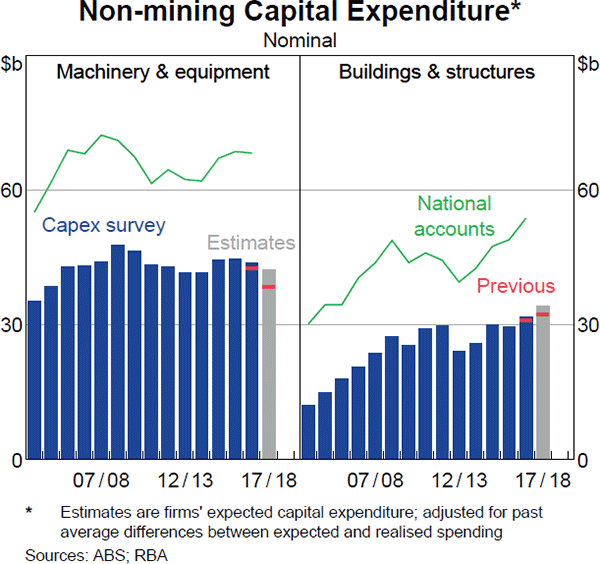
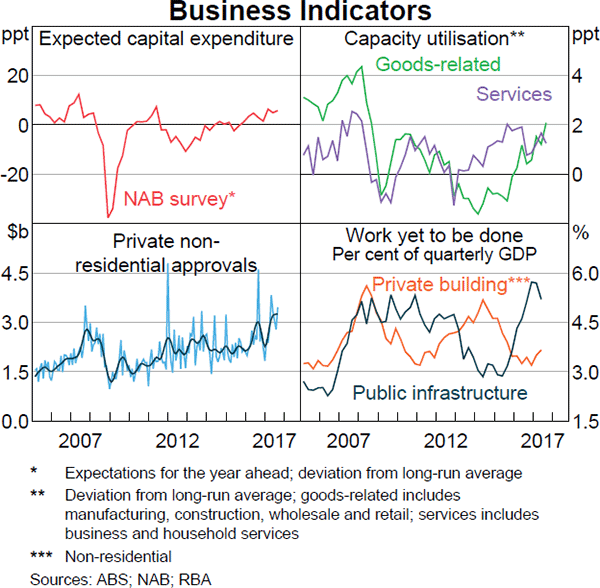
Non-resource exports have contributed strongly to economic growth since the exchange rate peaked in 2013 (Graph 3.18). Service exports have contributed around ¼ percentage point to GDP growth over the past year, largely driven by education and tourism. Rural export volumes have also contributed to GDP growth in recent quarters, following the record winter crop harvest. Manufactured exports have been little changed over the past year.
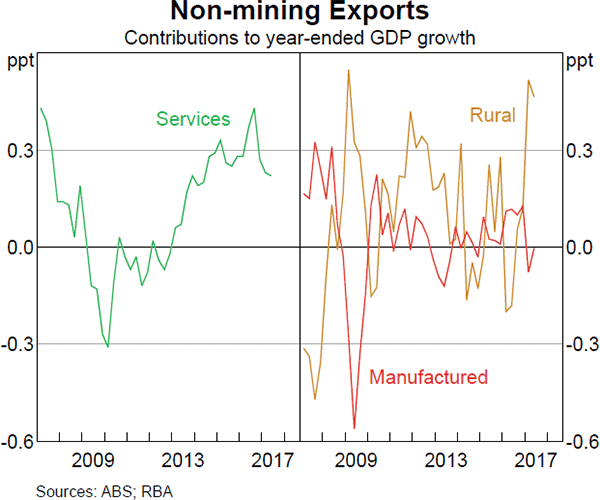
Labour Market
Labour market conditions have improved markedly over the past six months. Employment has grown by 3 per cent over the year and most of the increase has been in full-time employment. The participation rate has risen to its highest level since 2012; the increase over the year has been fairly broad based across all states, and most pronounced for older workers and females aged 35–44 years (Graph 3.19). The unemployment rate has declined a little over the past year to 5.5 per cent, which remains somewhat above the Bank's estimate of the rate that is consistent with full employment. A broader definition of labour market underutilisation, which captures the additional hours that underemployed people would like to work as well as hours of work sought by the unemployed, has also declined over the year. Leading indicators of labour demand, such as job advertisements and business's hiring intentions, continue to point to solid growth in employment over the next six months.
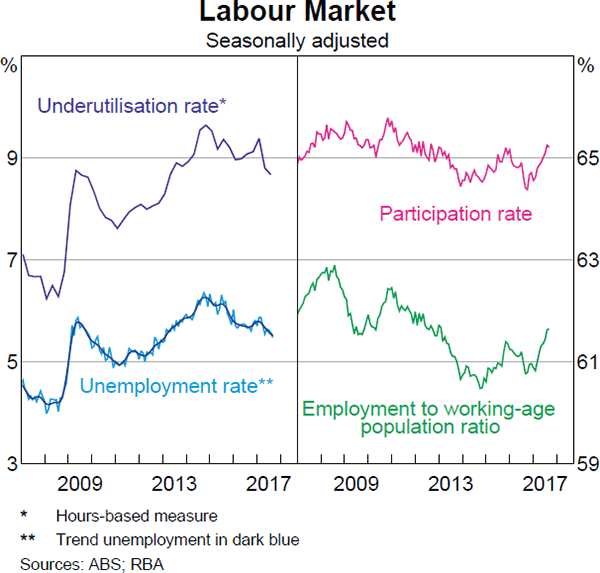
The improvement in labour market conditions has been broad based across Australia. The level of employment has increased in the mining-exposed states of Western Australia and Queensland since late 2016 and the unemployment rate in Western Australia has fallen noticeably (Graph 3.20). These data suggest that the labour market adjustment following the fall in the terms of trade and mining investment over recent years has largely run its course, although wage growth in mining-related parts of the economy remains low. Part of the adjustment in Western Australia and Queensland has occurred through a slowing in both net interstate and, more significantly, net overseas immigration. A large share of people leaving Western Australia are moving to Victoria, where population growth has been the strongest of all states in recent years due to strong net inflows from both interstate and overseas (Graph 3.21). It could be the case that these recent migrants to Victoria have higher participation rates than the average population, which would partly explain the strong rise in the Victorian participation rate over recent years.
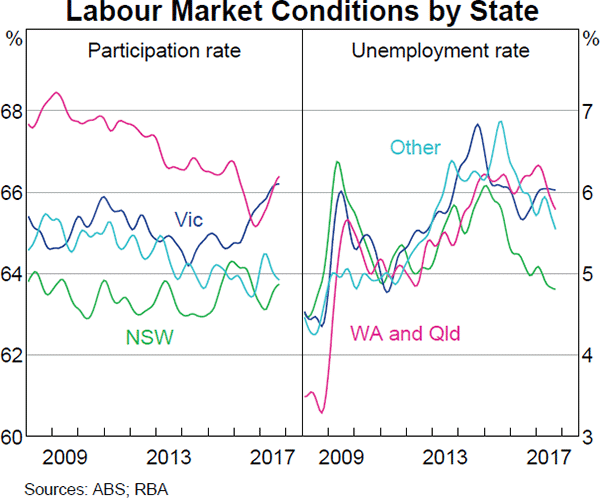
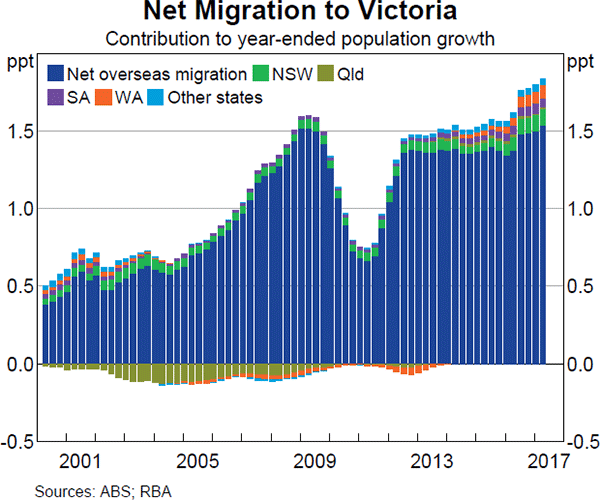
Employment growth remains strongest in the household services sector, particularly in health care and social assistance.[2] The growth in health-related employment has occurred across all states and, at the occupational level, there has been particularly strong growth in the number of jobs in nursing, aged and disabled care, as well as for other health professionals, such as physiotherapists and occupational therapists. The rollout of the National Disability Insurance Scheme over the next few years and the gradual ageing of the population should continue to boost employment in this industry. Construction employment has also risen over the past year as a result of the residential and infrastructure building occurring in the eastern states. There has been little change in employment in other goods-related industries, such as retail, mining and manufacturing, in recent years. Surveys of business's job vacancies suggest that there is continued demand for workers in health care, administration & support (which includes labour hire firms) and construction. The Bank's liaison program has heard reports of shortages of workers with specialised IT skills and workers for some specific roles related to the construction industry.
Labour Costs
Wage growth remains low across a range of measures. The wage price index (WPI) has grown at a slow but stable rate since last year, increasing by a little less than 2 per cent over the year to the June quarter (Graph 3.22). Growth in average earnings from the national accounts (AENA) – a broader but more volatile measure of earnings – has been particularly slow in the past few years and is at its weakest on a sustained basis since at least the mid 1960s. As the largest component of household income, the low growth in labour income over recent years has contributed to below-average growth in consumer spending and has been associated with low inflation.
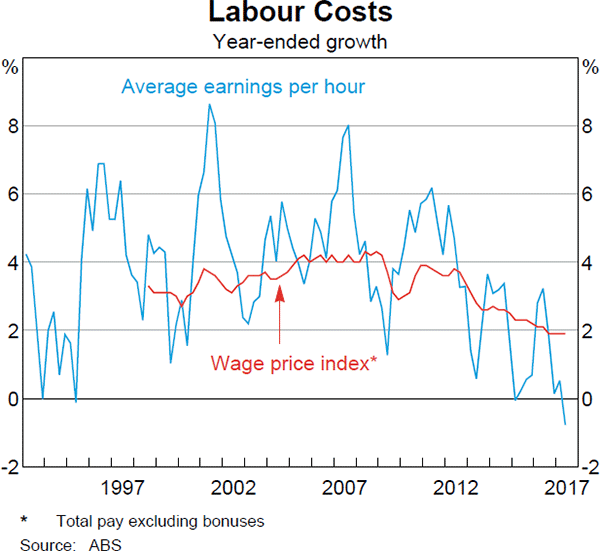
Spare capacity in the labour market continues to contribute to low wage growth. The unemployment rate remains somewhat above the Bank's estimate of the rate consistent with full employment and a considerable fraction of employees would like to work more hours.
A number of other factors are potentially associated with the low level of wage growth, including a lower level of job mobility, concerns around job security, changes in relative bargaining power, trends in labour productivity and structural change in the economy associated with technological change and increased competitive pressures from the internationalisation of services trade. The Australian experience of low wage growth is common with a number of advanced economies, including some with tighter labour markets. This common experience points to similar factors weighing on wage growth across a range of countries.
The adjustment of the economy to the end of the mining investment boom and the earlier decline in the terms of trade is evident in recent wage developments. Average wage rates have been declining for several years in Western Australia and Queensland, relative to the rest of Australia, following an increase over the previous decade (Graph 3.23). Reports from the Bank's liaison program suggest that wage freezes had become increasingly common in the mining states over recent years, though there are tentative signs emerging that their frequency is declining.
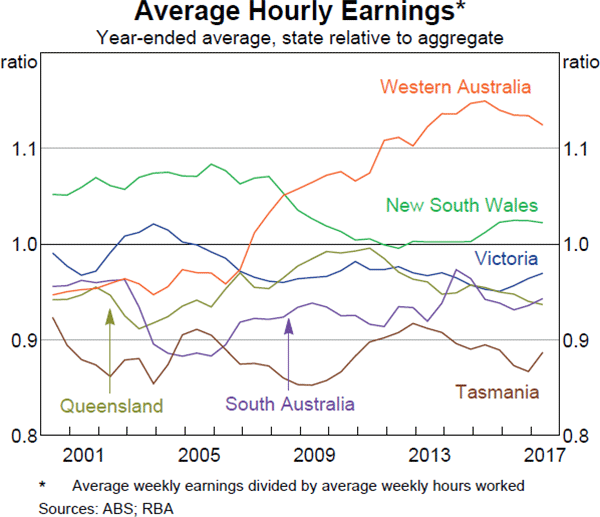
The adjustment following the terms of trade boom has involved the movement of some workers from high-paying jobs in mining-related industries to similar but lower-paying jobs in the non-mining economy. For example, workers employed in mining construction may have moved to jobs in civil and residential construction. Rebalancing in the Western Australian labour market is also influencing wage outcomes in other states through an increase in net interstate migration to the eastern states, boosting the supply of workers there.
The WPI is a measure of growth in wages that is designed to be unaffected by changes in the composition of the workforce. AENA captures a broader range of labour earnings than WPI as well as the effects of changes in the composition of employment. Growth in AENA has been noticeably weaker than WPI over recent years, particularly in Western Australia and Queensland. This difference isn't explained by workers shifting from higher-paying industries to lower-paying industries; rather, compositional changes within industries seem to be lowering average earnings. Over recent years, reports from the Bank's liaison program have suggested both an increase in the proportion of new employees hired on lower salaries than their predecessors and downward pressure on non-wage payments, such as allowances.
Wage growth remains relatively low across all industries and states, though some differences across industries appear to reflect trends in activity and the nature of pay-setting arrangements. Wage growth remained relatively high in education and healthcare, which have recorded the largest employment gains over the past year (Graph 3.24). These industries also have a large share of employees on collective agreements and it will take some time for the current low rate of wage growth to pass through to their stock of existing enterprise bargaining agreements; average annualised wage increases for new agreements remain below those in the stock of existing agreements (Graph 3.25). Meanwhile, wage growth remains relatively weak in the business services sector, including in professional, scientific and technical services where the largest share of employees are on individual agreements. Construction sector wage growth has picked up slightly over the past year, alongside strength in activity and employment in the industry. The Bank's liaison contacts, as well as information from business surveys, suggest that the availability of suitable labour has declined in some industries, though this only appears to have led to upward pressure on wages in select roles.
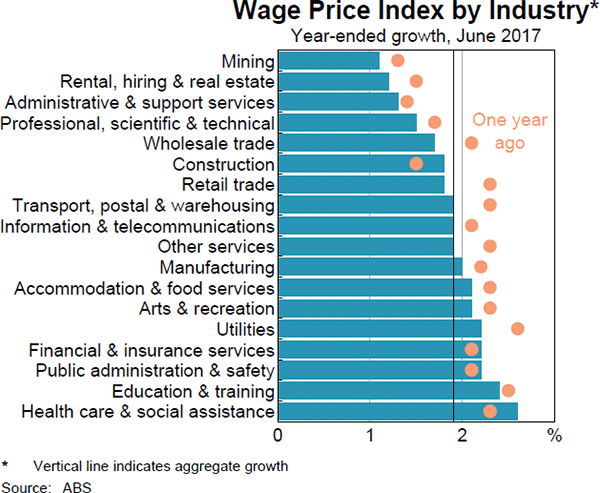
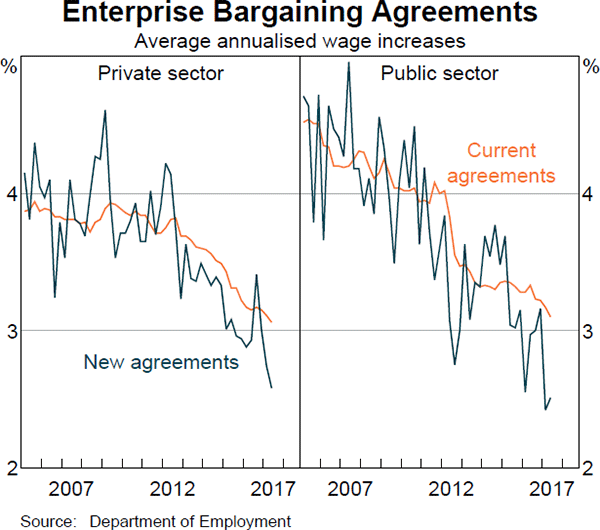
Information from the Bank's liaison suggests that private sector wage growth increased in the September quarter, and that the Fair Work Commission's (FWC) decision to increase award wages by 3.3 per cent was a contributing factor. Around one-quarter of all employees are covered by awards and this share has increased materially over recent years.[3] Further to this, wages of close to one-fifth of employees are linked to changes in award wages through conditions specified in their collective agreements or individual arrangements, although the size and timing of the FWC decision's impact is uncertain for these employees. Beyond the impact of the FWC decision, the Bank's liaison points to a modest improvement in private sector wage growth over the year ahead.
Footnotes
The Capex survey only covers about half of the non-mining business investment captured by the more comprehensive national accounts measure; it does not cover certain industries, such as some service industries, or certain types of investment, such as in software and research & development. [1]
Analysis of the recently released ABS Experimental Labour Accounts indicates discrepancies between jobs estimates reported by businesses and households, particularly on an industry basis. This suggests that caution should be applied to the interpretation of the quarterly employment data by industry, which may be somewhat overstated or understated, depending on how people describe their industry in the Labour Force survey. [2]
See RBA (2017), ‘Box C: Minimum Wage Decision’, Statement on Monetary Policy, August, pp 42–43. [3]